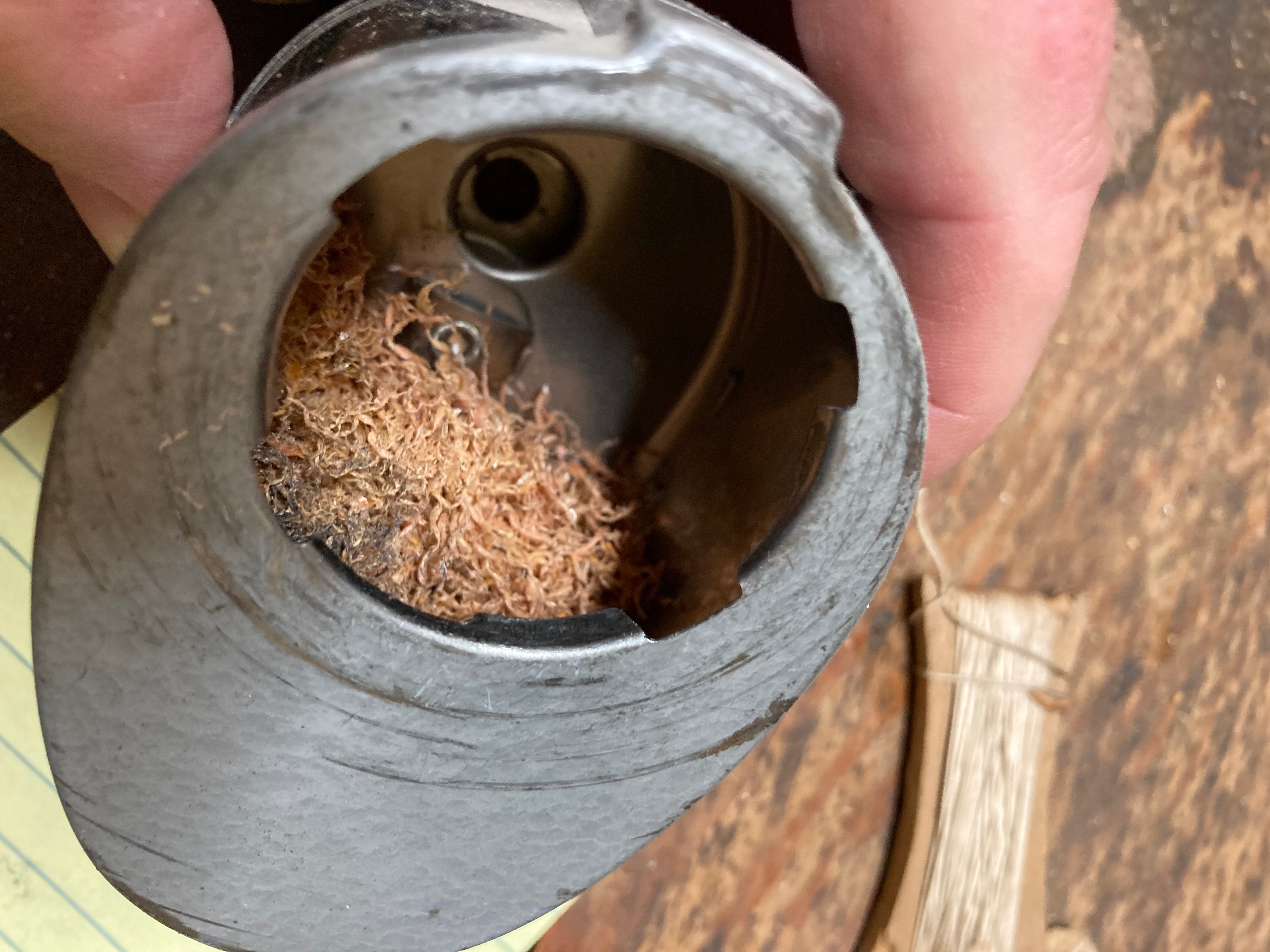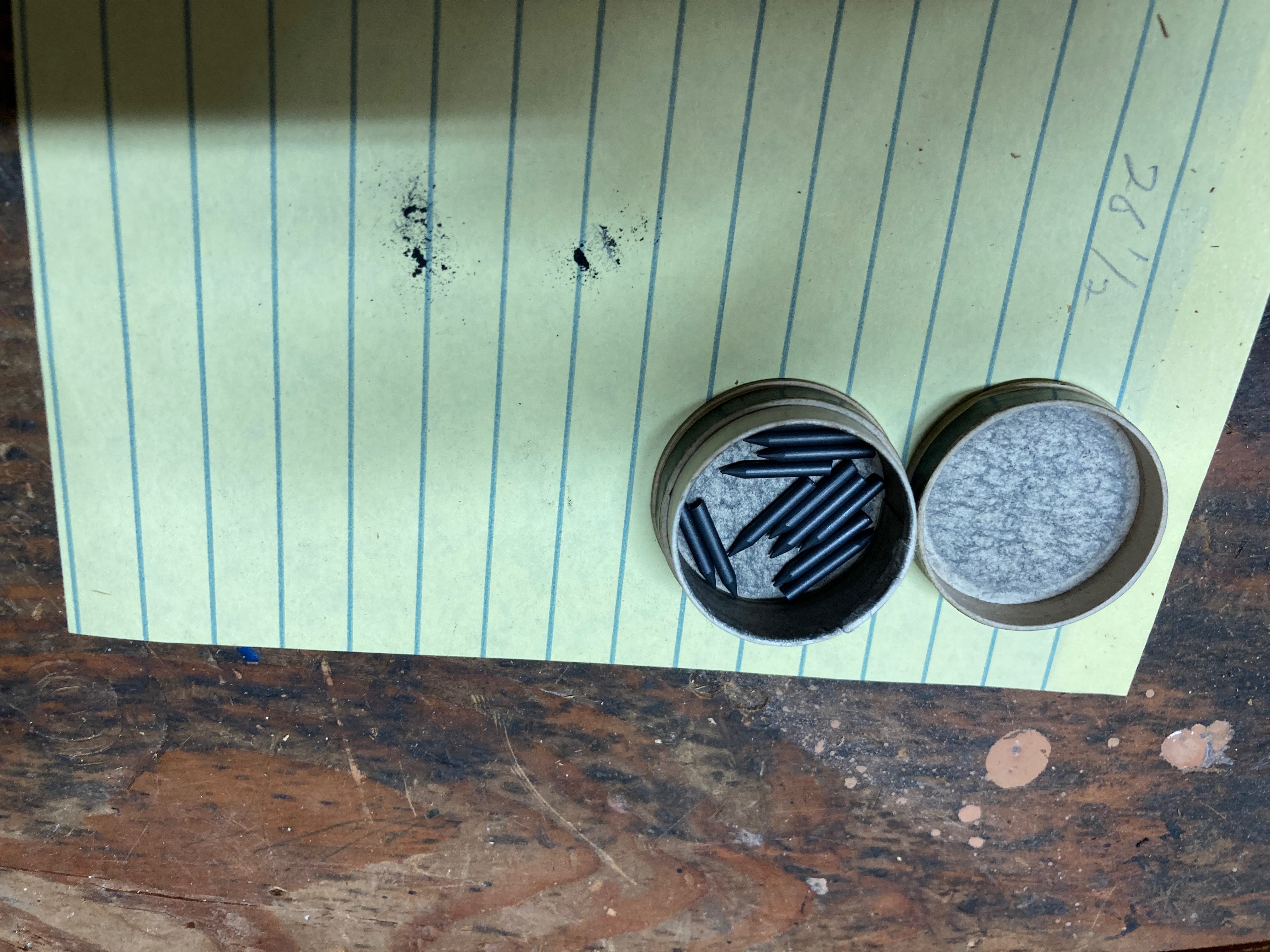Such a dark reference.
As you may know John - iron is also odorless! Yet for whatever scientific reason, when we touch iron it produces a very specific smell due to the interaction of organic compounds on our body. So while iron or metal may be required to produce this smell, it’s indeed something else - yet this process is dependent on iron or similar catalysts and creates something novel and distinct.
Perhaps this is similar to our experience with graphite (along with whatever wax, cedar or other components involved). We could go on with petrichor, geosmin and all sorts of other chemical compounds. But we speak through our experience, and when we try and communicate with others, there is often a nexus to that experience. (smell of rain, graphite pencils, iron, etc.) I’d like to think that wine is a way of re-enchanting our post-enlightenment world - so much of it is inexplicable and yet there it is.
A quick Google search found a result saying pencil lead is made from graphite mixed with clay (not wax). I’ve been using pencils my whole life, and there’s definitely a signature smell to the “lead”, which is different that the composite smell of shavings (“lead”, wood, paint).
We see this “you’re not really smelling that” stuff with other descriptors, especially minerals, I think that misses the point if there’s usually an associative smell. It’s missing the forest for the trees. Saying we aren’t smelling something distinctive when we clearly are isn’t helpful, nor is claiming we’re wrong when we misinterpret a very strong correlation as the source. So, maybe it’s something in the clay or some other ingredient that’s usually in pencil lead that the smell comes from. We aren’t imagining it, and it’s not the wood.
I’ve used pencils that clearly had wax. They suck ass. There’s a gunky feel when you write. They smudge and make a terrible mess trying to erase (and coat the eraser). Might as well use a pen, since the whole point of pencildom isn’t there. It’s pencildumb.
My current pencils have virtually no aroma.
Perhaps now, after years of sloppy usage. But I don’t think 10 or 15 years ago, before “graphite” became a common wine descriptor for some critics, no one would have had a clue what they were talking about.
Of course nobody knew what ‘liquid Viagra’ was before RMP coined it either! ![]()
A quick Google search found a result saying pencil lead is made from graphite mixed with clay (not wax). I’ve been using pencils my whole life, and there’s definitely a signature smell to the “lead”, which is different that the composite smell of shavings (“lead”, wood, paint).
We see this “you’re not really smelling that” stuff with other descriptors, especially minerals, I think that misses the point if there’s usually an associative smell. It’s missing the forest for the trees. Saying we aren’t smelling something distinctive when we clearly are isn’t helpful, nor is claiming we’re wrong when we misinterpret a very strong correlation as the source. So, maybe it’s something in the clay or some other ingredient that’s usually in pencil lead that the smell comes from. We aren’t imagining it, and it’s not the wood.
I’ve used pencils that clearly had wax. They suck ass. There’s a gunky feel when you write. They smudge and make a terrible mess trying to erase (and coat the eraser). Might as well use a pen, since the whole point of pencildom isn’t there. It’s pencildumb.
My current pencils have virtually no aroma.
Yes, it’s clay typically, not wax. I was misremembering that.
As I said in the thread with the experiment, there did seem to be a faint smell from some of the pencils that was distinct from cedar. Perhaps that is something in the clay. I came on something that said there could be sulfur compounds in the clay.
Even if that’s the case, do you really think that’s what people are referring to in wines, particularly Bordeaux? Or is it just cedar/cigar box, which is classic – and typical of pencil shavings – and they’ve conflated pencil shavings with pencil lead/graphite?
The smell of this pencil graphite is absolutely something I sometimes get in Bordeaux and Loire Cab Franc.
Yes, it’s clay typically, not wax. I was misremembering that.
As I said in the thread with the experiment, there did seem to be a faint smell from some of the pencils that was distinct from cedar. Perhaps that is something in the clay. I came on something that said there could be sulfur compounds in the clay.
Even if that’s the case, do you really think that’s what people are referring to in wines, particularly Bordeaux? Or is it just cedar/cigar box, which is classic – and typical of pencil shavings – and they’ve conflated pencil shavings with pencil lead/graphite?
Is cigar box analogous to pencil shavings? To me, cigar box is somewhat the overlap of cedar aromas and tobacco in a more perfumed way (since you have a pretty aromatic wood and the wrapper of the cigar which is also quite aromatic too). Graphite is more a mix (to me) of iron, mineral, smoke like notes, and when present with cedar, comes across as pencil shavings. I think I saw the same website you did - which mentioned mercaptans and sulphur compounds - this makes sense to me. Our olfactory system being what it is, there are all sorts of thresholds and sensitivities that inform our experience of smell. For whatever reason, there’s an association with graphite/lead and those notes in wine and it’s remarkably consistent.
… Graphite is more a mix (to me) of iron, mineral, smoke like notes, and when present with cedar, comes across as pencil shavings. …
Do you mean the term “graphite” or the material?
I agree that cigar box has tobacco notes as well as cedar (obviously)
… they’ve conflated pencil shavings with pencil lead/graphite?
No. They align but are distinct. Perhaps similar to the people who cannot distinguish corked aromas: they just don’t “get” it?
Sorry folks, I agree with John here. I shaved the pencil leads from my grandfather’s drafting set–absolutely no odor. The pencil shavings from my ancient pencil sharpener in my shop smell exactly like “graphite”.


Sorry folks, I agree with John here. I shaved the pencil leads from my grandfather’s drafting set–absolutely no odor. The pencil shavings from my ancient pencil sharpener in my shop smell exactly like “graphite”.
But the point is that they smell nothing like any other kind of cedar. They smell distinctly of pencils.
Not to be repetitive, but my understanding is that they are mostly made from California incense cedar. How much California incense cedar have you smelled, aside from in pencils?
As I said in the thread with the experiment, there did seem to be a faint smell from some of the pencils that was distinct from cedar. Perhaps that is something in the clay. I came on something that said there could be sulfur compounds in the clay.
Even if that’s the case, do you really think that’s what people are referring to in wines, particularly Bordeaux? Or is it just cedar/cigar box, which is classic – and typical of pencil shavings – and they’ve conflated pencil shavings with pencil lead/graphite?
Yes, when I’ve used “graphite” it probably is a sulfur compound I’m describing. I’ve noted both cedar and graphite in wines, as independent descriptors. Taylor put it well, above. “Graphite” has a sort of acrid character, tobacco/cigar box/cedar have a warmth of comforting aromatics.
Had to Google, but-
TIL what TIL means
Ditto. Probably won’t remember it tomorrow…
Not to be repetitive, but my understanding is that they are mostly made from California incense cedar. How much California incense cedar have you smelled, aside from in pencils?
I wonder if that was true even of the German-made Staedler pencils we tested alongside American-made Dixon Ticonderogas.
And I see now that I have a British-made Staedtler. I think it may be time for pencil wood terroir tests!
And we need to be mindful of the graphite composition. “Hard” pencil lead is only about 20-25% graphite, whereas “soft” is up to 90% graphite.
Our senses can mislead us if we aren’t careful! It would be like drinking a wine out of the wrong glass - we think we’re drinking Cab Franc but instead we’re drinking Pinot Gris.